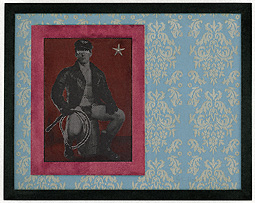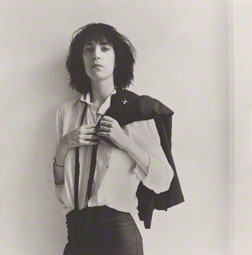 |

 |
 |
Thomas, Robert Mapplethorpe, negative 1987; print 1994. Jointly acquired by the Los Angeles County Museum of Art, with funds provided by The David Geffen Foundation, and The J. Paul Getty Trust. © Robert Mapplethorpe Foundation
|
 |
A tastemaker and provocateur, Robert Mapplethorpe was one of the great photographers of the second half of the twentieth century. His highly stylized explorations of gender, race, and sexuality became hallmarks of the period and exerted a powerful influence on his contemporaries.
In 2011 the J. Paul Getty Trust and the Los Angeles County Museum of Art jointly acquired art and archival materials by or associated with Robert Mapplethorpe. The vast majority was a generous gift from the Robert Mapplethorpe Foundation and the remainder was purchased with funds provided by the David Geffen Foundation and the Getty Trust. This exhibition and the Los Angeles County Museum of Art's concurrent show Robert Mapplethorpe: XYZ celebrate this landmark acquisition.
Mapplethorpe's strong, uncluttered compositions of statuesque male models fused a classical sensibility with homoerotic content at a time when the male nude was not a popular subject among camera artists. In this image, the model's body is taut with compressed energy, his muscled limbs bent in a way that is reminiscent of those seen on ancient Greek figure vases.
|
 |

 |
 |
Leatherman #1, Robert Mapplethorpe, 1970. Jointly acquired by The J. Paul Getty Trust and the Los Angeles County Museum of Art. Partial gift of The Robert Mapplethorpe Foundation; partial purchase with funds provided by The J. Paul Getty Trust and the David Geffen Foundation. © Robert Mapplethorpe Foundation
|
 |
 |
Born in Queens, New York, Mapplethorpe studied graphic arts at Pratt Institute in Brooklyn. His early work included collage, found objects, and jewelry. Before he took up the camera, Mapplethorpe often used pictures he cut out of magazines as collaged elements to explore sexuality and eroticism.
By altering this fetishistic image and re-presenting it in a shadow box, Mapplethorpe removed the picture from its original context and elevated it to a homoerotic icon. The five-pointed star is a symbol of religious significance and the plastic mesh covering the figure evokes the metal screens commonly found in confessionals in Roman Catholic churches.
In 1972 Mapplethorpe met two influential curators: John McKendry, who gave him a Polaroid camera, and Samuel Wagstaff Jr., who became the artist's lover and mentor. By the mid-1970s, Mapplethorpe had acquired a medium format camera and began documenting New York's gay S&M community.
|
 |
|
Mapplethorpe met writer-musician Patti Smith in 1967, and they lived together as intimate and artistic partners until 1974. This image of Smith was one of his earliest celebrity portraits.
The two collaborated to create this image as the cover for her 1975 debut rock album, Horses. Working in a borrowed apartment, Mapplethorpe suggested using a wall adjacent to a window where a triangle of light fell at a certain time in the afternoon. Smith dressed in men's clothes and channeled the American entertainer Frank Sinatra with her jacket slung over her shoulder. Her uncombed hair and androgynous look broke radically from the image that the music industry expected women in rock to assume.
|
 |
|
Mapplethorpe refined his style in the early 1980s, creating images of timeless elegance. After his erotic nudes, his delicate floral still lifes encouraged sexual interpretations. Although floral still lifes have traditionally held these connotations, Mapplethorpe transformed them from a subject that sophisticated collectors were reluctant to display in their homes into an important contemporary theme.
Arranged with his characteristic sense of balance and meticulously lit, this image of a calla lily appears to glow from within. Although preternaturally still, the composition exudes a sense of latent excitement, with the milky white flower almost vibrating against the rich, black background.
|
 |
 |

 |
 |
Ken and Lydia and Tyler, Robert Mapplethorpe, negative 1985; print 2004. Jointly acquired by the Los Angeles County Museum of Art, with funds provided by The David Geffen Foundation, and The J. Paul Getty Trust. © Robert Mapplethorpe Foundation
|
 |
 |
|
Mapplethorpe often evoked classical themes in his work, particularly in his nude figure studies. In this image, he began with the motif of the Three Graces as depicted by artists from the ancient Greeks to the nineteenth century, but took the reference in fresh directions.
He selected one female and two male models of different racial backgrounds to achieve a range of skin tones from light to dark and to invite new, non-binary interpretations of gender, race, and sexual preference. Mapplethorpe trained his lens on the models' conjoined bodies, purposely excluding their heads from the frame. Although he identified his models by name in the title, instead of a portrait, he created an elegant study of form and tone.
|
 |

 |
 |
Self-Portrait, Robert Mapplethorpe, 1985. Jointly acquired by the Los Angeles County Museum of Art, with funds provided by The David Geffen Foundation, and The J. Paul Getty Trust. © Robert Mapplethorpe Foundation
|
 |
 |
From 1970 until his untimely death in 1989, Mapplethorpe continually returned to the self-portrait as a means of expression.
Inspired by a sculpture he had in his own collection, Mapplethorpe made this picture as an experiment in motion. The double portrait that resulted represents a sharp break with his earlier self-depictions, in which he adopted various guises. This image suggests powerful awareness of the transience of life and his vulnerable position in the face of the AIDS crisis.
Mapplethorpe died at age forty-two from complications of AIDS. A year earlier, he established a foundation to support the causes he believed in, such as art programs and HIV/AIDS prevention and care.
|
 |





